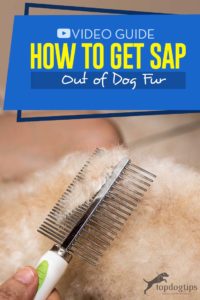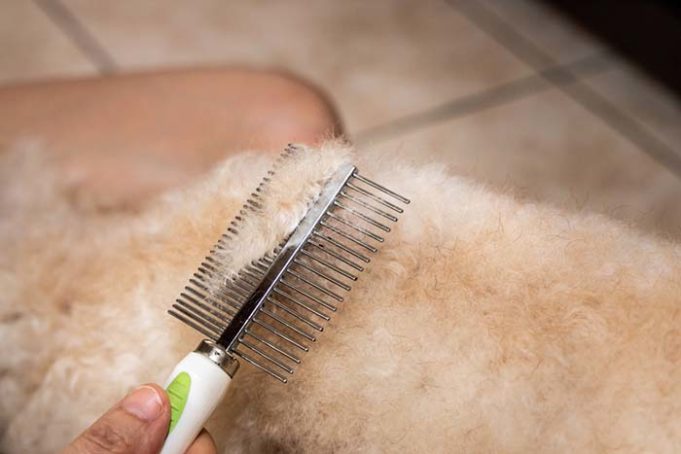Dogs have a tendency to get into sticky situations, and sometimes that involves messing with sap or getting into sap outdoors.
As the sap is sticky, when you don't notice and remove it quickly, it can attract extra debris like rocks, dirt, and pine straw which stick and can become painful for the dog.
Some owners are at a loss about the proper procedure of how to get sap out of dog fur without harming them.
 Removing tree sap from your pup's fur is a simple and reasonably easy process that can be completed using everyday household items.
Removing tree sap from your pup's fur is a simple and reasonably easy process that can be completed using everyday household items.
Some methods can be time-consuming depending on how much sap and debris have been collected in their fur or by their paws.
Is Sap Safe For Dogs?
Sap, in general, is a pain to deal with for both you and your pup.
It causes their hair to be matted; depending on the pine tree, the sap can be toxic to the dog's skin.
Certain pine saps can cause rashes and skin irritation.
In some cases, dogs will get sap on their paws.
They will obviously try to lick it off, but too much sap ingestion can cause worse problems like vomiting and upset stomach.
Removing Sap from Dog's Fur
It is essential that you start the process correctly, or it can cause the entire situation to become worse, and you're more likely to become frustrated and make mistakes.
The most important thing to remember when removing sap from fur is that the dog is being affected and that you must be careful not to pull harshly at its fur as it may become irritated, and the dog will be jumpy.
A smooth, step-by-step solution is to:
1) When inspecting the area, take note of whether the sap has hardened or not.
If the sap has hardened, it must be softened before you remove it.
A hairdryer (or pet dryer) on it's lowest setting can be used to soften the sap.
Test the dryer on yourself first to determine a safe distance where the air feels warm but not hot.
2) If the sap is soft, you can loosen it by using different oils and oily products. It can be loosened by using olive oil, mineral oil, or smooth peanut butter.
Massage the product into the affected fur and allow it to sit for a few minutes.
Make sure that the product is safe for the dog to ingest, as they may attempt the lick the area to remove the product from their fur.
3) After the product has been left to sit, use a wide-tooth comb or your fingers to work the sap out of the dog’s fur.
You will need to move slowly and carefully to prevent pulling on their fur too much.
As you brush through their fur, use a paper towel or washcloth to wipe some of the oily substance and residue off.
4) Not all patches will come out easily, and if there are small portions of the sap left in the fur, you can trim them out with the use of scissors.
It this is not an option, repeat steps 1-3 until sap has been removed or is not noticeable.
Residual sap will work its way out of the fur over time and after a few shampoos.
5) The final step is to do a last wash of the dog.
Wash them with a dog-friendly shampoo, and some dog shampoos are explicitly meant for getting heavy debris out of fur and using war water.
It may be necessary to wash the area more than once to get all of the product out of the fur.
If there is still sap stuck in the dog’s fur, a trip to the groomer may be needed.
They will have access to stronger cleaning products that are still safe for use on the dog and will be able to trim the areas that the sap is stuck to.
Most groomers are experienced in the situation and may be able to give you tips regarding where to cut and where to apply oil if the situation ever happens again.
Removing Sap from Dog's Paws
You may often find sap not only on the dog's body but also trapped in the fur around their paws and sometimes in their tail as well.
A dog's paws are more sensitive than the fur on its body and require a gentle touch when trimming or cleaning, especially when attempting to remove an embedded material.
Cleaning your dog's paws will take more time than their normal fur and should not be rushed to prevent unintentionally pulling on the fur and causing the dog to become skittish.
A smooth, step-by-step solution is:
1) Like with normal fur, check to see if the sap has hardened. If it has, work slowly to soften it with the hairdryer.
Make sure that the dryer is set on the lowest setting and watch for any signs of discomfort shown by the dog.
2) Once the sap is softened, apply olive oil, mineral oil, or peanut butter to the area.
Massage it gently into their paws, wash with dog-friendly shampoo, and rinse with warm water.
3) Any areas where the sap is not easily removed should be trimmed instead of harshly scrubbed.
Use a surgical clipping blade to remove the affected fur; if you are uncomfortable doing so, make an appointment with a groomer and explain the situation.
 When attempting to get sap out of dog fur, it is vital that you work quickly and effectively.
When attempting to get sap out of dog fur, it is vital that you work quickly and effectively.
The longer the sap remains on the fur, the harder it will become and the more difficult it will be to remove.
Remember that some types of sap can be toxic to the dog and cause health issues and irritation if it is ingested or comes into direct contact with their skin.
Identify the tree that the sap originated from and call the vet if the dog begins to experience symptoms related to an allergic reaction or symptoms such as nausea, weakness, vomiting, or skin irritation or rashes.
READ NEXT: The Ultimate List of Toxic and Safe Plants, Seeds for Dogs













